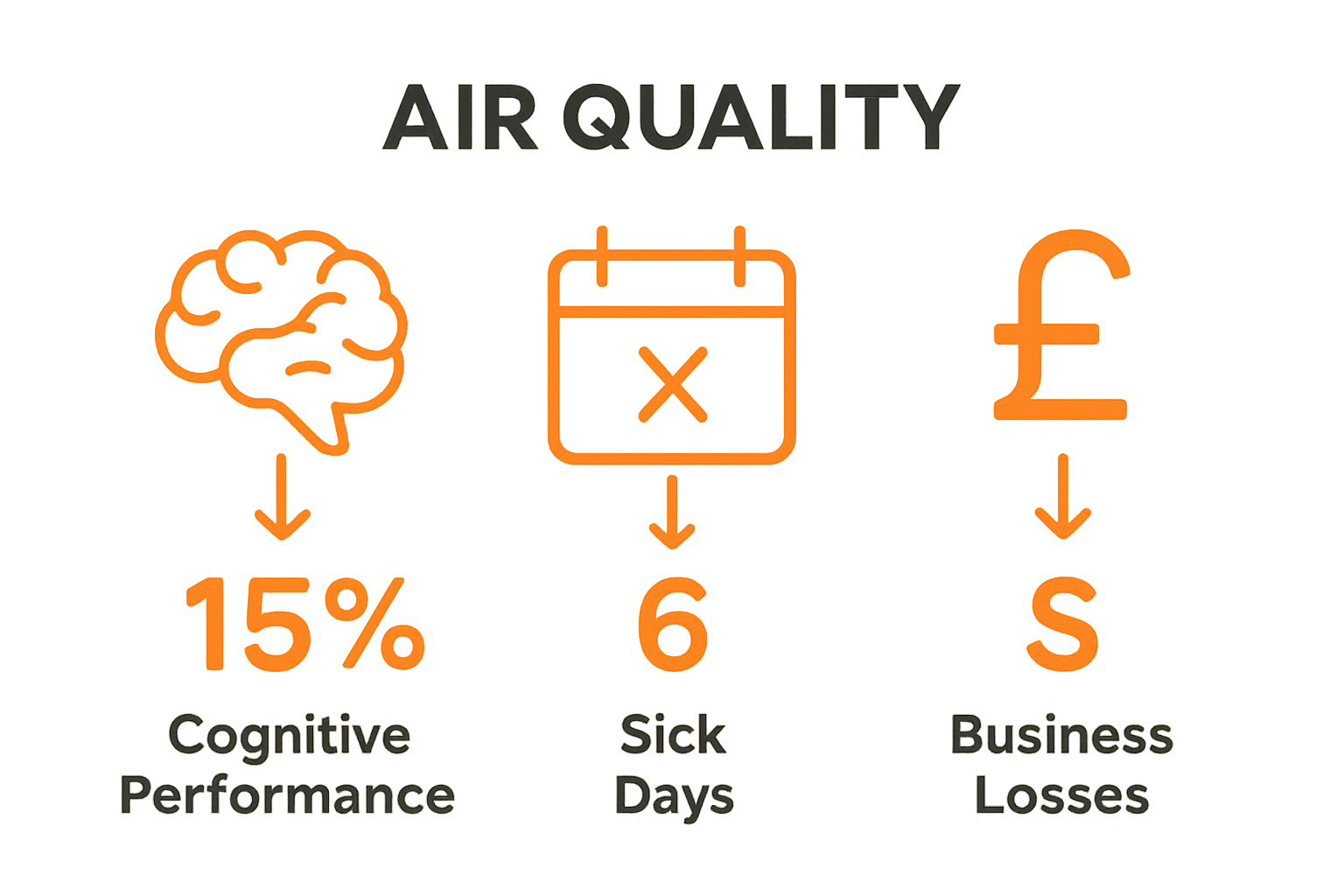Indoor air quality shapes every breath you take inside a workplace and it can make or break comfort and productivity for millions across the UK. You might think the occasional patch of stuffy air is hardly worth a second thought. Yet British businesses lose about £13 billion each year to poor indoor air conditions making fresh air a valuable asset that is too often overlooked.
Table of Contents
- What Is Indoor Air Quality And Its Importance?
- Why Indoor Air Quality Matters For Health And Productivity
- How Indoor Air Quality Affects Different Sectors
- Key Components Of Indoor Air Quality Improvement Strategies
Quick Summary
| Takeaway | Explanation |
|---|---|
| Prioritise indoor air quality (IAQ) | Investing in IAQ enhances employee health and productivity, showcasing commitment to worker welfare. |
| Implement effective ventilation systems | Proper ventilation is legally required and crucial for reducing indoor pollutants and maintaining healthy air conditions. |
| Monitor and manage air pollutants | Regular testing and management of pollutants like VOCs and CO2 can improve workplace health outcomes. |
| Tailor strategies for specific sectors | Each sector has unique air quality concerns, necessitating customised approaches to effectively address these issues. |
| Understand the economic impact of poor IAQ | Poor indoor air quality can cost businesses billions due to decreased productivity and increased health-related absences. |
What is Indoor Air Quality and Its Importance?
Indoor air quality (IAQ) represents the atmospheric condition within buildings that directly impacts human health, comfort, and productivity. In the United Kingdom, businesses increasingly recognise that the air employees breathe significantly influences workplace performance and wellbeing.
Understanding Indoor Air Quality Fundamentals
Indoor air quality encompasses the overall composition of air inside commercial, industrial, and institutional spaces. Multiple factors contribute to IAQ, including temperature, humidity, ventilation, and the presence of pollutants. Research from the Health and Safety Executive highlights that adequate ventilation isn’t just a recommendation but a legal requirement under workplace health regulations.
Key components affecting indoor air quality include:
- Chemical pollutants from cleaning products
- Particulate matter from machinery and industrial processes
- Biological contaminants like mould and bacteria
- Volatile organic compounds (VOCs) from furniture and building materials
- External pollution infiltrating indoor environments
Health and Economic Implications
Poor indoor air quality can lead to significant workplace challenges. Employees exposed to substandard air conditions may experience reduced cognitive performance, increased sick days, and higher rates of respiratory issues.
British businesses lose approximately £13 billion annually due to workplace health-related productivity losses, with indoor environmental quality playing a substantial role.

Moreover, organisations can proactively address indoor air quality through strategic interventions. Read our comprehensive guide on improving workplace air quality to understand comprehensive strategies for creating healthier work environments.
The economic and health benefits of maintaining superior indoor air quality extend far beyond immediate workplace comfort. By prioritising air quality, businesses demonstrate commitment to employee welfare, potentially reducing long-term healthcare costs and enhancing overall organisational performance.
The following table summarises key workplace air pollutants discussed in the article and their impacts on employee health and productivity.
| Pollutant Type | Source Examples | Potential Health Impact |
|---|---|---|
| Chemical pollutants | Cleaning products | Respiratory irritation, allergic reactions |
| Particulate matter | Machinery, industrial processes | Respiratory issues, lowered immune function |
| Biological contaminants | Mould, bacteria | Allergies, infection risk |
| Volatile organic compounds (VOCs) | Furniture, building materials | Long-term cardiovascular and respiratory risks |
| External pollution | Air infiltration from outdoors | General health decline, worsened indoor air conditions |
Why Indoor Air Quality Matters for Health and Productivity
Indoor air quality represents a critical yet often overlooked aspect of workplace environment that directly influences employee health, cognitive performance, and organisational productivity. Understanding its profound impact is essential for modern British businesses seeking to create optimal working conditions.
Health Consequences of Poor Air Quality
Prolonged exposure to substandard indoor air can trigger a range of health complications. Research from the Grantham Research Institute demonstrates that poor air quality correlates with significant health and economic challenges. Employees consistently exposed to indoor air pollutants may experience:
- Respiratory tract irritations
- Increased frequency of allergic reactions
- Higher susceptibility to chronic respiratory conditions
- Compromised immune system functionality
- Potential long-term cardiovascular risks
Productivity and Performance Implications
Beyond health concerns, indoor air quality directly impacts workplace productivity. Poor air quality can reduce cognitive function by up to 50%, leading to decreased concentration, slower decision making, and diminished overall work performance. British organisations lose substantial economic value through reduced employee efficiency and increased sick leave.
Learn more about infection control strategies that can help mitigate air quality related health risks in workplace environments.
Critical sectors such as education, healthcare, and industrial manufacturing are particularly vulnerable to indoor air quality challenges. By implementing comprehensive air quality management strategies, businesses can create healthier, more productive workspaces that support employee well-being and organisational performance.
How Indoor Air Quality Affects Different Sectors
Indoor air quality is not a one-size-fits-all concern. Each sector experiences unique challenges and consequences related to air quality management, requiring tailored strategies and interventions to protect employee health and organisational performance.
Educational Environments
Research from the UK Ministry of Housing, Communities & Local Government underscores the critical importance of air quality in institutional settings. Schools and universities face distinctive indoor air quality challenges that directly impact learning outcomes and student well-being.

Key air quality concerns in educational settings include:
- High occupancy rates creating dense pollutant concentrations
- Increased respiratory sensitivity among young learners
- Potential long-term developmental impacts
- Higher risks of airborne transmission of infectious diseases
- Limited ventilation in older educational infrastructure
Industrial and Manufacturing Sectors
Manufacturing environments present complex indoor air quality challenges stemming from intricate production processes. Chemical emissions, particulate matter, and machinery-generated pollutants create sophisticated air quality management requirements.
Critical industrial air quality considerations encompass:
- Machinery-generated particulate emissions
- Chemical and solvent vapour concentrations
- Potential heavy metal particle contamination
- Thermal processing pollution
- Mechanical ventilation system effectiveness
Explore our comprehensive infection control solutions designed to mitigate air quality risks across diverse workplace environments.
By recognising sector-specific indoor air quality nuances, organisations can develop targeted strategies that protect employee health, maintain regulatory compliance, and sustain optimal workplace performance.
This table outlines the main indoor air quality challenges faced by different sectors and their associated consequences, as highlighted in the article.
| Sector | Primary Air Quality Challenges | Key Consequences |
|---|---|---|
| Educational Environments | High occupancy, limited ventilation, infectious spread | Impacted learning, increased illness among students |
| Industrial/Manufacturing | Chemical emissions, particulates, machinery pollutants | Greater health risks, regulatory compliance complications |
| General Commercial Workplaces | Pollutants, poor ventilation, VOCs from materials | Reduced cognitive and work performance, sick leave rises |
Key Components of Indoor Air Quality Improvement Strategies
Developing comprehensive indoor air quality improvement strategies requires a multifaceted approach that addresses various environmental and technological considerations. British businesses must adopt systematic methods to ensure optimal workplace air conditions.
Ventilation and Air Exchange Systems
Research from the Health and Safety Executive highlights ventilation as a critical component of indoor air quality management. Effective air exchange systems are fundamental to removing pollutants, reducing contaminant concentrations, and maintaining healthy workplace environments.
Key ventilation strategy components include:
- Regular maintenance of HVAC systems
- Implementation of mechanical and natural ventilation techniques
- Monitoring air exchange rates
- Installing high-efficiency particulate air (HEPA) filters
- Creating strategic air circulation pathways
Pollutant Detection and Management
Comprehensive indoor air quality strategies necessitate advanced monitoring and mitigation techniques. Proactive pollutant management involves identifying, measuring, and systematically reducing potential air quality hazards.
Critical pollutant management approaches encompass:
- Carbon dioxide (CO2) level monitoring
- Volatile organic compound (VOC) detection systems
- Humidity and temperature control mechanisms
- Regular air quality testing protocols
- Implementing source control strategies
Discover energy-efficient solutions that can simultaneously improve indoor air quality and reduce operational costs.
By integrating sophisticated monitoring technologies, robust ventilation systems, and targeted pollutant management approaches, organisations can create healthier, more productive workplace environments that prioritise employee well-being and operational excellence.
Create Safer and Healthier Workspaces by Enhancing Indoor Air Quality
Are you concerned about harmful dust, chemicals, and airborne pollutants entering your business? As the article explains, poor indoor air quality results in increased sick days, reduced productivity, and puts staff health at risk. Simple changes, such as upgrading your entrance and interior floor coverings, can capture significant contaminants before they spread, supporting better air throughout your building.

Take action today with Mats4U. Discover our range of custom entrance mats and specialist floor solutions, designed to trap dirt and pollutants at the door and help maintain cleaner, safer air for your staff and visitors. With options for every industry and made-to-measure sizes, you can make a real difference for your team’s well-being and create a professional first impression. Explore our full selection and start building a healthier workplace environment now by visiting our homepage.
Frequently Asked Questions
What is indoor air quality (IAQ)?
Indoor air quality (IAQ) refers to the condition of air within buildings, affecting human health, comfort, and productivity. It encompasses factors like temperature, humidity, ventilation, and the presence of pollutants.
Why is indoor air quality important for businesses?
Indoor air quality is crucial for businesses as poor air quality can lead to reduced employee health, increased sick days, and lower productivity levels, ultimately affecting overall organisational performance and profitability.
How can businesses improve indoor air quality?
Businesses can improve indoor air quality through strategies such as enhancing ventilation systems, using high-efficiency air filters, conducting regular air quality testing, and managing pollutants effectively.
What are the health effects of poor indoor air quality?
Poor indoor air quality can lead to respiratory issues, allergic reactions, compromised immune function, and long-term health risks, significantly impacting employee well-being and productivity.









